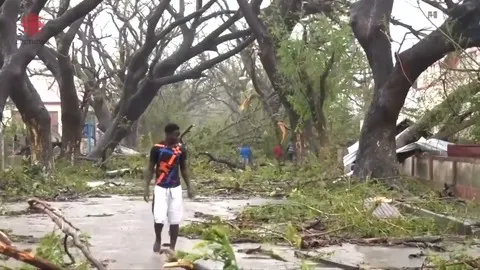
UN: Death toll will rise as waters recede after Cyclone Idai
Flooding and heavy rains from and after the cyclone have caused an urgent humanitarian crisis
More than a week has passed since Cyclone Idai made landfall in southern Africa, and UN officials are now saying the final casualty figure will be impossible to tally until flood waters have receded.
Idai made landfall Thursday March 14 near the city of Beira with winds of 177 km/h -- the equivalent of a high-end Category 2 hurricane -- along with pounding, torrential rains and storm surge as high as six metres in some areas. It is this surge and heavy rainfall that have left an enormous region inundated, even more than a week later. Thousands remain trapped by floodwaters, with some 1.7 million people impacted across the region.
Mozambique officials raised the country's death toll to 417 on Saturday, putting the loss of life at roughly 700 people across Mozambique, Zimbabwe, and Malawi. That number is expected to rise as floodwaters diminish and cut-off areas can be reached.
In the city of Beira, near the point of landfall, the storm was so powerful that as much as 90 per cent of structures may have been either damaged or destroyed.
WATCH BELOW: AERIAL VIDEO OF THE CITY OF BEIRA SUBMERGED AFTER THE CYCLONE
"INLAND OCEAN"
The storm's weather impacts are still ongoing, with rivers bursting their banks over a wide area. Aid agencies that have entered the area and conducted aerial surveys say thousands of people remain trapped. Save the Children said earlier this week a 50-km stretch of land remains all but underwater.
"In many places, no roofs or treetops are even visible above the floods. In other areas, people are clinging to rooftops desperately waiting to be rescued," Machiel Pouw, an official with the charity Save the Children, told CNN.
Herve Verhoosel of the World Food Program told the Associated Press the overflowing rivers have created "inland oceans extending for miles and miles in all directions," Verhoosel said.
"People visible from the air may be the lucky ones and the top priority now is to rescue as many as possible," he said.
International aid is gradually penetrating the area, but the storm has washed away numerous roads in lower-lying areas. Some charities have been air dropping in food and supplies to the worst-hit areas, but with ground infrastructure in such a state, getting the aid where it needs to go will be a challenge.
The devastation is also raising fears of disease outbreaks, such as cholera, due to the contamination of water supplies, the Red Cross says.
SOURCES: BBC | Associated Press | CNN











